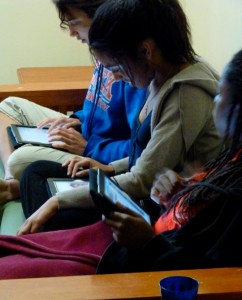
After last year's experience with taking iPad to the field I am finally getting around to reporting back on the 4 week long field research experience with iPad this summer, when we were able to equip our whole field school team (the faculty, a graduate student TA, three undergraduate students and myself) with iPads. Goal for this year was to more extensively explore iPad as a team and to see where it might be useful as a research tool.
Every member of the team was equipped with:
- iPad2, GPS, 3G, wireless 60GB
- Power Support HD Anti-Glare Film for iPad 2 ($35)
- BoxWave Capacitive Stylus ($15)
- CaseCrown Apple iPad 2 Bold Standby case for iPad 2 ($25)
Preparation
Before handing out the iPads I installed the following additional Apps.
- Writing: iAwriter, Docs to Go, Audio Note, Note Taker, Penultimate, Dragon Dictation, WritePad, Evernote (all sorts of notes)
- Reading: GoodReader, iAnnotatePDF, Kindle, iBooks
- Dropbox
- Multimedia: iMovie HD, PhotoPad
- Mapping: Google Earth (viz maps through Google MyMaps), KMZ loader, TopoMaps, BitMap, PDFMaps, Mapster, GeoMaps. Atlas, MapBox, ESRI ArcGIS, ESRI BAO, ESRI Place History, Zillow
- Tracking: iCMTGIS, GPSnote, GPSTrack, GPSHD, GPS Kit HD, GaiaLite, Trails
I also added the iPads to the "Find my iPhone" app and made students aware of the fact that I would be able to track the location of their iPad. Fortunately, this was not necessary.
Upon arrival on the field location in South Carolina I provided students with a brief introduction to the device and the software, asked them to explore the Apps, and offered they could request additional Apps if they found one potentially useful. I also instructed them on to set up their email and a passcode lock.
Use in the Field

None of the students had ever owned an iPad. All of the students owned a smartphone, one of which was an iPhone.
The field school consists of 2 weeks of travel, introduction and shadowing an 2 weeks individual project work for the students.
Overall, there was great variability in the use of the device over the course of the field school as well as between individuals. iPad were more used during the phases of the field school that required note taking. The issue of using a the iPad while in conversation with an informant was raised particularly with everyone the group, even though students did use the device in interview situations. Some students were more inclined to take risks and try new things while others were more focused on sticking with what works reliably. There are different preferences as with regard to typing or handwriting notes. Prior familiarity with a similar technology may have influenced the ease with which this new devices was handled.

The applications that the students most extensively ended up using were: GPS Kit, GPSTrack, Audionote, iAnnotatePDF, Video/camera, Mail, Safari, Map, Virtuoso (one student, who worked on a music project)
When prompted for feedback in the end, portability of the device, the ability to go online and browse everywhere and the Audionote app to record and take notes for research purposes were the most valuable features that stood out for everyone.

Faculty use differed somewhat from student use as iPad also served heavily as a portable repository for books and articles related and relevant for the research. A shared repository in Evernote was used to exchange material between me and the faculty, collected in archives and as field notes.
We also used the iPad, in combination with a highly portable portable projector (Optoma PK301 Pico Pocket) and speakers, for documentary film screenings.
Finally we built on last year's use of iPad to capture GPS points, not only on foot, to mark certain locations, or to track routes while being taken on a tour. We also for the first time systematically and successfully collected GPS points from the car for a particular research project, and combined those points with video footage shot simultaneously out of the side of the car window.
Conclusion
We have been able to show a range of possibilities - by no means exhaustive - and potential for the use of the iPad in the field. However, we have also observed striking individual differences in the use of the device, admittedly in a very small sample. Still, this raises the question if blanket solutions and broad introductions of this new technology fail to take into account the variability in backgrounds, attitudes, preferences in learning and working styles and other factors that may impact the user (student and faculty in our case) and make this device work for some but not for others.